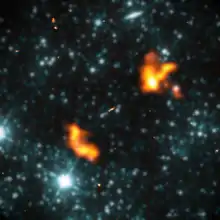Alcyoneus (galaxy)
Alcyoneus is a radio galaxy located around 3 billion light years away in the constellation Lynx, discovered using the Low-Frequency Array (LOFAR) network. At around 5 million parsecs (16.3 million light years) wide, its radio lobes are the largest known structure made by a single galaxy.[1] The host galaxy, SDSS J081421.68+522410, also contains a supermassive black hole weighing 400±200 million solar masses. Aside from the size of its radio emissions, the galaxy is otherwise of ordinary radio luminosity, stellar mass, and supermassive black hole mass. It is a standalone galaxy, with the nearest cluster located 11 million light years away from it.[1] It was named after Alcyoneus, one of the opponents of Heracles in Greek mythology.
| Alcyoneus | |
|---|---|
 Alcyoneus, depicted through LOFAR radio data at 144 MHz (orange) and WISE infrared data at 3.4 micron (blue) | |
| Observation data (J2000 epoch) | |
| Constellation | Lynx |
| Right ascension | 8h 14m 21.6s |
| Declination | 52° 24′ 10.06″ |
| Redshift | 0.24674±0.00006 |
| Distance | 3 billion ly |
| Characteristics | |
| Mass | 240 billion ± 40 billion (host) M☉ |
| Other designations | |
| SDSS J081421.69+522410.0, 2MASS J08142169+5224103 | |
References: [1] | |
It is currently unknown how Alcyoneus's radio emissions grew so large. A few theories have been proposed, including a lesser dense than usual environment surrounding it, the fact that it exists inside a filament of the cosmic web,[2] a supermassive black hole, an extensive stellar population, and powerful jet streams.[3]
References
- Oei, Martijn S. S. L.; van Weeren, Reinout J.; Hardcastle, Martin J.; Botteon, Andrea; Shimwell, Tim W.; Dabhade, Pratik; Gast, Aivin D. J. G. I. B.; Röttgering, Huub J. A.; Brüggen, Marcus; Tasse, Cyril; Williams, Wendy L.; Shulevski, Aleksandar (February 14, 2022). "The discovery of a radio galaxy of at least 5 Mpc". arXiv:2202.05427 [astro-ph.GA].
- Turner, Ben (February 17, 2022). "Largest galaxy ever discovered baffles scientists". Live Science. Retrieved February 18, 2022.
- "Astronomers find largest radio galaxy ever". Universiteit Leiden. February 16, 2022. Retrieved February 18, 2022.